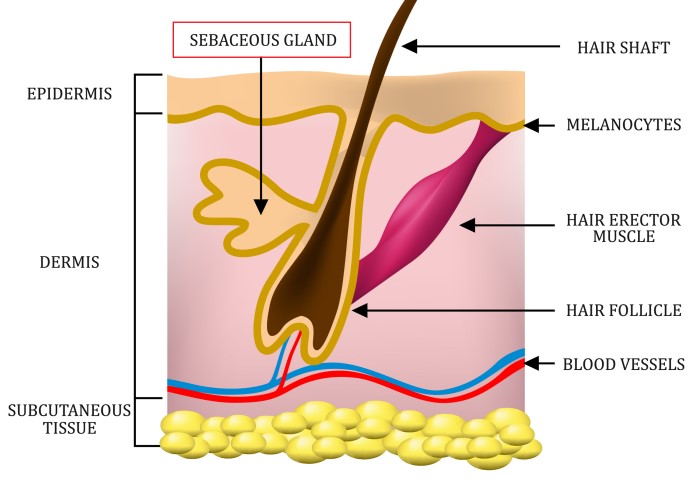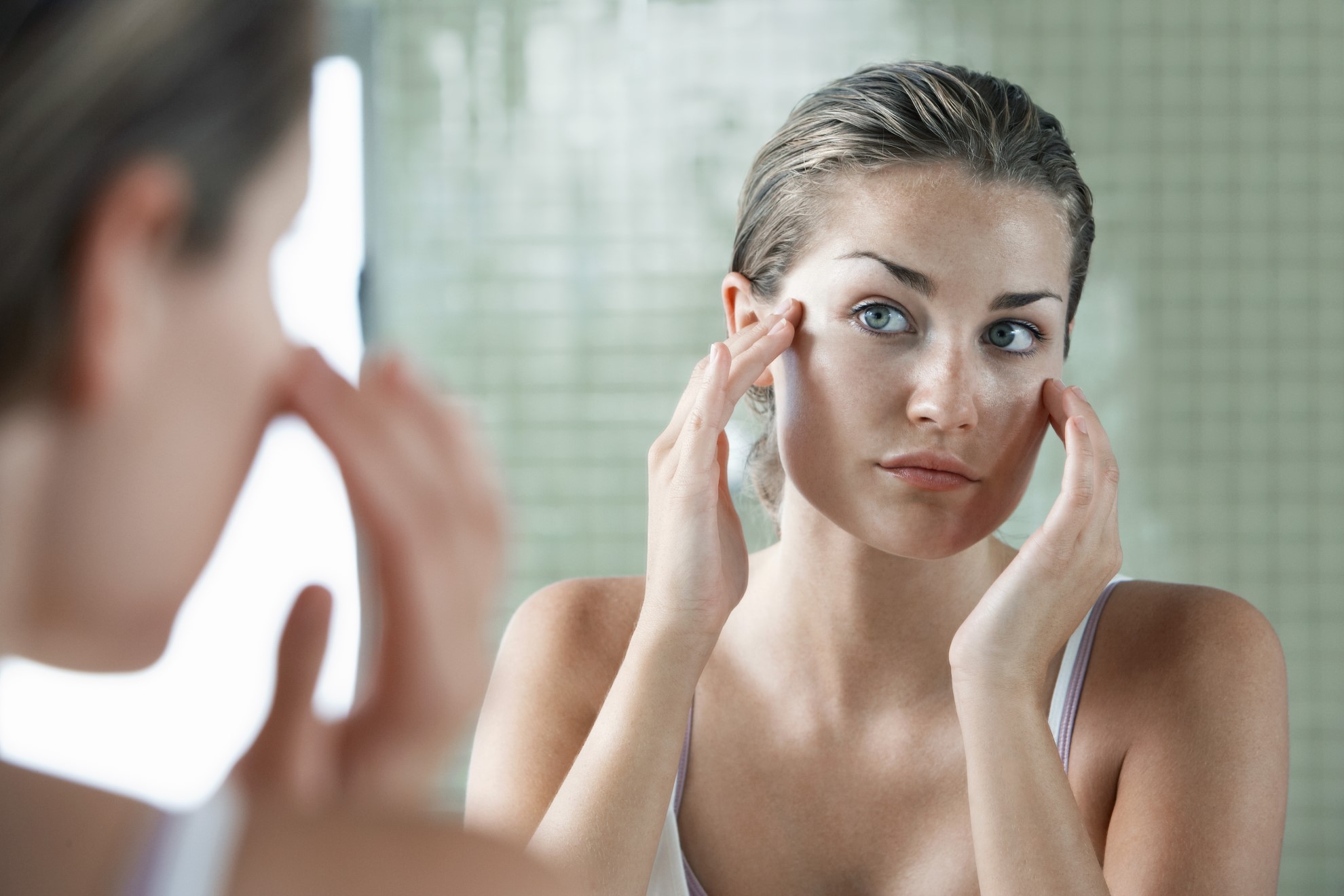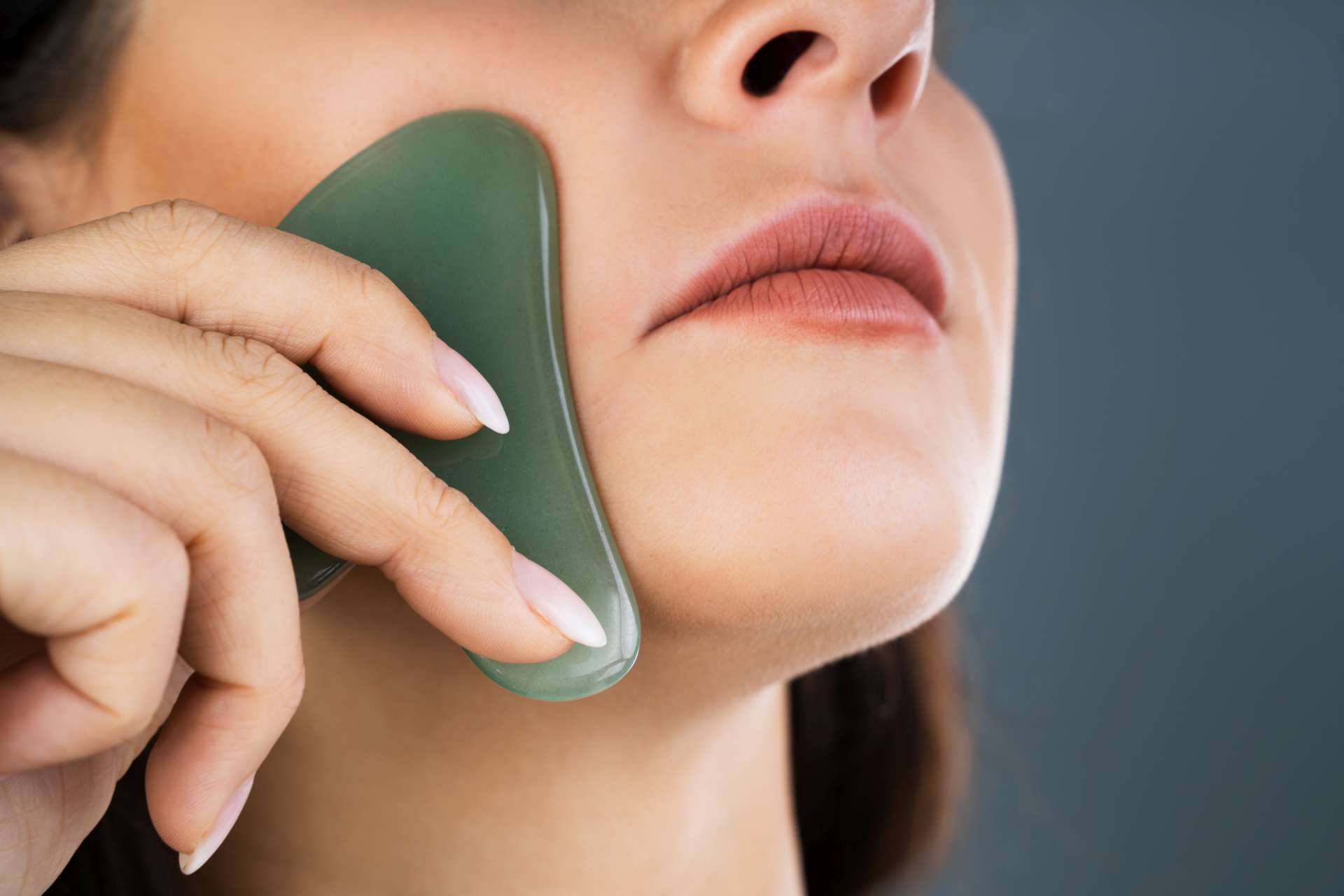The epidermis is the largest organ of the human body. This epidermis performs multiple functions including insulation, protection of vital organs as well as vanity. The Epidermis releases some amount of natural oil to keep the skin lubricated and protected. But, some people experience excess oil production than others. The Epidermis is composed of numerous layers.
The sebaceous glands that are present around the upper portion of the epidermal layer produce natural oils called sebum. Sebum is a complex mixture of fatty acids, wax, sugars along with other natural chemicals that prevents moisture from evaporating. Sebum is waxy and oily in terms of consistency and helps the skin retain moisture, stay hydrated, and protect the skin from harmful friction.
In some cases, the sebaceous gland starts to produce more than necessary sebum which can lead to oily skin along with other skin problems.

Excess sebum can often leave an oily sheen on the skin making it appear shiny. The extra sebum production also causes the pores to become blocked that can lead to breakouts, blackheads, and pimples. For Some people, the skin starts to become greasy after a few hours of washing.
It can get hard to know how to approach this problem when most of the skincare remedies don’t seem to work. There are multiple causes that can lead to oily skin.
Before learning about the appropriate skin care for oily skin one should know the cause that leads to this problem.
Factors that cause Oily Skin:
There are many factors that lead to your skin becoming extra oily.
The recognition and identification of these factors can help you find the right skincare products based on your skin’s requirements. These factors are:
- Age:
The age of a person has direct effects on the production of sebum. It is easy to notice the skin losing its elasticity due to a lack of collagen as one ages. The production of oil help the skin retain moisture and stay lubricated. Hence, as the person ages, the production of oil starts to decline.
- Hormones:
One of the main causes of the overproduction of oil and sebum is the imbalance of hormones. Sebum production significantly rises during the periods of puberty as well as pregnancy.
- Genetics:
Genetics is extensively responsible for the composition of one’s skin type. If parents or blood-related family members have the tendency to overproduce sebum, the next of the kin might have a high chance of inheriting this problem.
- Location:
The weather, climate, and topography also contribute to the production of oil and sebum. The hot and humid climate in summers or monsoons, in tropical and subtropical areas, can lead to excess production of oil. In cold and arid areas or during winter and fall seasons the production of oil and sebum is significantly low.
- Pores:
Sebum rises to the surface through the pores around the hair follicles. The size of the pores has direct effects on the production of oil and sebum. Factors like aging, weight, weather, hormones, and even breakouts can make your pores larger. Larger pores tend to produce more oil.
- Products:
Using the wrong skin products with mineral oils, beeswax, alcohol, and paraffin should be avoided. These products add unnecessary oil to the epidermis, clog the pores as well as irritate the skin.
Key Symptoms of oily skin type:
Oily skin often affects the face, you might have an oily skin type if the skin exhibits the following symptoms:
- The appearance of the face often seems shiny, greasy, and oily after a few hours of washing.
- The skin often has large open pores
- It is difficult for makeup to stay on the face, as it often slides off
- The greasier parts of the face like the T-Zone often have pimples, blackheads, whiteheads, large or clogged pores, and acne.
At-Home Skin Care Treatments and Tips for Oily skin:
Excess oil on the skin can lead to clogged pores, breakouts, acne, and leave an oily sheen on the face. Sebum has multiple benefits for the skin and completely eradicating it might lead to another set of skin problems. The sebum helps the epidermis preserve moisture, helps retain the skin’s elasticity, decelerates the aging process, and protects the skin from friction as well as damage.
It is essential to use proper products to maintain a healthy oil balance on the skin without tampering with the skin’s natural moisture. Here are some at-home skin treatments to help control excessive production on the skin.
- Wash your face routinely:
Washing your face regularly reduces the build-up of excess oil on the skin. The incorporation of the following methods can help with maintaining the oil balance of the skin:
- Use a gentle facewash along with warm water
- Avoid using face washes with heavy chemical components that can irritate or eradicate the oil from the skin leaving it feeling dry.
- Avoid using harsh towels on the face, as the extensive friction can cause the skin to produce more oil.
- Good Chemicals and Acids:
The Incorporation of good chemicals and acids in the daily skincare routine can reduce as well as prevent the build of excess oil on the skin. Invest in products that contain acids and chemicals like:
- Niacinamide: improves the excessive production of sebum and oil, reduces the appearance of enlarged pores, and makes the skin firm.
- Salicylic Acid: breaks down fatty cells on the skin surface like sebum. Salicylic acid reduces the production of sebum on the skin surface.
- BHA (Beta-Hydroxy Acid): suitable for combination and oily skin.
- Benzoyl Peroxide: helps reduce acne, pimples, and the production of excess oil.
- Toners:
Facial cleansers and moisturizers have a significant contribution in reducing the production of excess oil on the skin. But, Toners is the best product for reducing the appearance of oily skin.
Astringent toners with high alcohol content can often dry out the skin. Hence, it is important to check the contents of the toner before applying it. Prefer investing in toners that contain green tea, witch hazel, and other natural astringents with anti-inflammatory properties.
- Gel-Based Moisturizers:
Many people having oily skin completely eliminate the moisturizers from their skincare routines. Completely eliminating the moisturizing step can make your skin feel very dry and accelerate the aging process.
It is important to avoid using cream-based and oil-based moisturizers and instead use oil-free moisturizers.
Gel-moisturizers are highly effective for people with acne-prone or oily skin, as it does not add extra oil to the already oily skin surface. Invest in moisturizers that incorporate vitamin E, aloe Vera, and hyaluronic acid to help soothe as well as retain moisture in the skin without making the skin appear oily.
Along with gel-based moisturizers prefer buying oil-free, gel-based, or water-based sunscreens to protect the skin from sun damage that can accelerate the production of sebum.
- Scrubbing and Exfoliation:
It is quite essential to regularly exfoliate oily skin to prevent excess build-up of oil, dead skin cells, acne, clogged pores, and blackheads.
Using gentle manual scrubs and chemical exfoliators can be a good addition to a skincare routine. Prefer using chemical peels that incorporate BHA(Beta-Hydroxy Acid) to thoroughly remove dead skin and excess oil.
Home Remedies For Oily Skin:
The excess production of sebum is the main cause of oily skin. Along with the incorporation of the Treatments and tips, adding the following natural home remedies can help achieve great results at home
- Honey:
Honey is one of the best natural remedies for skin problems. Honey is a natural humectant, meaning it helps the skin retain moisture without making your skin oily. Honey has multiple anti-bacterial and anti-septic properties that are highly beneficial for extremely oily as well as acne-prone skin.
- Honey as a cleanser:
In order to use honey as a mask, apply a thin layer on the face and leave it to dry for 10 minutes. After 10 minutes rinse off with warm water. - Honey as a Moisturizer:
For moisturizing properties use honey with banana for oily skin.
Mix 1 teaspoon, organic honey, with half of the mashed banana and leave it on the skin for 10 to 20 minutes and rinse with warm water. - Honey as a scrub:
Use 2 tablespoons of blended organic oatmeal powder mixed with 1 tablespoon honey. Apply it on the neck and face, then gently scrub away. Later rinse it off with warm water. - Honey for rejuvenation:
Mix half cup of Fuller’s earth with 2 tablespoons of honey and apply a thick later on the face as well as neck and let it dry for 20 minutes. Once the mask is dry rinse it off with warm water.
- Clays:
Applying clay masks can help unclog pores and reduce the production of excess oil. The best clay mask for treating oily skin and acne is green clay. The French Green Clay Mask is a highly beneficial product for oily skin as it is highly absorbent and does not leave the skin feeling extra dry. - Aloe Vera:
Applying fresh aloe vera sap directly on the skin is good for people who have an oily skin type. Aloe vera is popularly known for its soothing and conditioning properties. One can use aloe vera right before bedtime and leave it overnight. - Oatmeal Mask:
Oatmeal contains anti-oxidants and anti-inflammatory properties that are beneficial to acne-prone as well as oily skin. Oatmeal is good for oily skin as it absorbs excess oil from the skin. Mix half a cup of blended oatmeal powder in hot water to form a paste and stir it well. Then add 1 tablespoon of honey and apply the mixture on the skin and leave it to dry for 5 minutes. Once the oatmeal mask is dry rinse it off with warm water and pat the skin dry. - Egg white and Lemon mask:
One of the best masks for oily skin is egg white and lemon mask. Both lemon and egg whites help in tightening the pores. The citrus acid, as well as antibacterial properties present in lemons, helps absorb oil. Mix 1 egg white with 1 tablespoon of lemon and apply it on the skin, leave the mask for 10 to 15 minutes and rinse.

